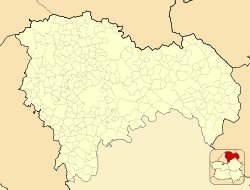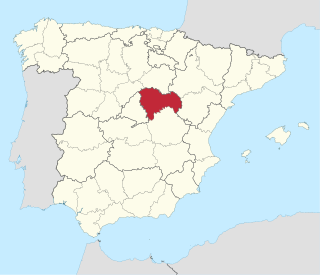
Guadalajara is a province of Spain, belonging to the autonomous community of Castilla–La Mancha. As of 2019 it had a population of 258,890 people. The population of the province has grown in the last 10 years. It is located in the centre of the Iberian Peninsula.

Úbeda is a municipality of Spain located in the province of Jaén, Andalusia.

The Sierra Morena is one of the main systems of mountain ranges in Spain. It stretches for 450 kilometres from east to west across the south of the Iberian Peninsula, forming the southern border of the Meseta Central plateau and providing the watershed between the valleys of the Guadiana to the north and the west, and the Guadalquivir to the south.

Aldeadávila de la Ribera is a village and municipality in the north-west of the province of Salamanca, western Spain, part of the autonomous community of Castile and León.

Cabo de Gata is a cape located in Níjar, Almería in the south of Spain, one of the biggest capes. It is the driest place in the Iberian Peninsula. However, the area that it occupies is not considered a desert, even though there is one nearby: the Tabernas Desert, located 30 km in a northwest direction. The lowest temperature registered in Cabo de Gata was 0.1 °C.

The motillas were the early settlements of La Mancha (Spain) belonging to the Middle Bronze Age, and connected to the Bronze of Levante culture. These were human-made hills atop of which are placed fortified settlements. Their height is usually between four and five meters and the motillas are separated from each other by a distance of four to five kilometers. Their construction started c. 2200 BCE and they were used for about 1000 years.

Sotorribas is a municipality of Spain located in the province of Cuenca, Castilla–La Mancha. As of 1 January 2020, it has a registered population of 700. The municipality spans across a total area of 149.21 km2.

Alustante is a municipality located in the judicial region of Molina de Aragón, in the province of Guadalajara, Castile-La Mancha, Spain. According to the 2008 census (INE), the village has a population of 236 inhabitants. It is situated in the south-east of Guadalajara (province), 190 km from the capital city Guadalajara, 64 km from Teruel, 114 km from Cuenca, 195 km from Zaragoza and 210 km from Valencia.

Molina de Aragón is a municipality located in the province of Guadalajara, Castile-La Mancha, Spain. According to the 2009 census (INE), the municipality had a population of 3,671 inhabitants. It held the record (−28.2 °C) for the lowest temperature measured by a meteorological station in Spain, and now it's on the third place.
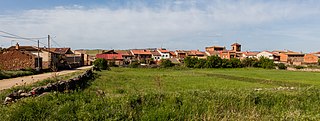
Montejo de Tiermes is a municipality located in the province of Soria, Castile and León, Spain. In 2010 the population of Montejo de Tiermes (municipality) was 198 inhabitants, 126 men and 72 women. Montejo de Tiermes (locality) had a population of 58 inhabitants on 1 January 2010, 41 men and 17 women.

The geology of the Iberian Peninsula consists of the study of the rock formations on the Iberian Peninsula, which includes Spain, Portugal, Andorra, and Gibraltar. The peninsula contains rocks from every geological period from the Ediacaran to the Quaternary, and many types of rock are represented. World-class mineral deposits are also found there.
Busot is a municipality in the Comarques of the comarca of Alacantí in the Valencian Community, Spain.

Andorra is located in the Axial Zone of the central Pyrenees mountain range in southwestern Europe, which means that it has intensely folded and thrust rocks formed when the Iberian peninsula was rotated onto the European continent.

The La Pedrera de Rúbies Formation, also called as La Pedrera de Meià is an Early Cretaceous (late Berriasian to early Barremian geologic formation in Catalonia, Spain. The formation crops out in the area of the Montsec in the Organyà Basin. At the La Pedrera de Meià locality, the formation consists of rhythmically laminated, lithographic limestones that formed in the distal areas of a large, shallow coastal lake. It is noted for the exceptional preservation of articulated small vertebrates and insects, similar to that of the Solnhofen Limestone.
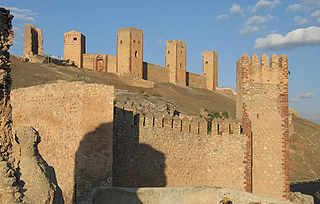
The Castle of Molina de Aragón is a fortification in Molina de Aragón, Castile-La Mancha, Spain. It was declared Bien de Interés Cultural in 1931.
The Chaco Basin is a major sedimentary basin in Central South America around the borders of Argentina, Bolivia and Paraguay. The basin forms part of the larger Paraná Basin. Superficially, the Chaco Basin is an alluvial basin composed of land-derived material, mostly fine sand and clays of Paleogene, Neogene and Quaternary age. On deeper levels the Paraguayan Chaco is made up by four sub-basins, the Pirizal, Pilar, Carandaity and Curupaity basins.

Barranco León is an archaeological site in Orce, Andalusia, Spain with an age range between 1.2 and 1.4 million of years. It is noted for having yielded evidence of hominin occupation, including the milk tooth of a boy or girl of 10 years. After the tooth had been dated, its original owner was hailed as having left the earliest anatomical evidence for humans in Western Europe.

The geology of the Canary Islands is dominated by volcanic rock. The Canary Islands and some seamounts to the north-east form the Canary Volcanic Province, whose volcanic history started about 70 million years ago. The Canary Islands region is still volcanically active. The most recent volcanic eruption on land occurred in 2021 and the most recent underwater eruption was in 2011-12.

The Guadyerbas is a river of Spain located in the centre of the Iberian Peninsula. It is the main left-bank tributary of the Tiétar, in turn a major tributary of the Tagus.
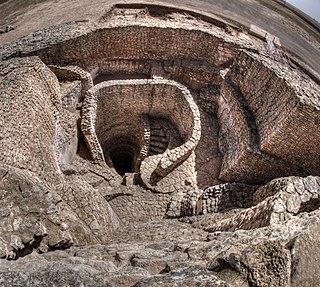
The Motilla del Azuer is a prehistoric fortification dating from the Bronze Age in the municipality of Daimiel, in the Province of Ciudad Real, Castilla–La Mancha, Spain.


